








Scientists have discovered a natural way to kill germs fast.
Now thousands of people are using it against viruses and bacteria that cause illness.
Colds and many other illnesses start when viruses get in your nose and multiply. If you don’t stop them early, they spread and cause misery.
Hundreds of studies confirm copper kills viruses and bacteria almost instantly just by touch.
That’s why ancient Greeks and Egyptians used copper to purify water and heal wounds. They didn’t know about viruses and bacteria, but now we do.
“The antimicrobial activity of copper is well established.” National Institutes of Health.
Scientists say copper’s high conductance disrupts the electrical balance in a microbe cell and destroys it in seconds.
The EPA recommended hospitals use copper for touch surfaces like faucets and doorknobs. This cut the spread of MRSA and other illnesses by over half, and saved lives.
The strong scientific evidence gave inventor Doug Cornell an idea. He made a smooth copper probe
with a tip to fit in the bottom of the nostril, where viruses collect.
When he felt a tickle in his nose like a cold about to start, he rubbed the copper gently in his nose for 60 seconds.
“It worked!” he exclaimed. “The cold never happened. I used to get 2-3 bad colds every year. Now I use my device whenever I feel a sign I am about to get sick.”
He hasn’t had a cold in 10 years.
Users say:
“It works! I love it!”
“I can’t believe how good my nose feels.”
“Is it supposed to work that fast?” “One of the best presents ever.” “Sixteen flights, not a sniffle!”
“Cold sores gone!”
“It saved me last holidays. The kids all got sick, but not me.”
“I am shocked! My sinus cleared, no more headache, no more congestion.”
“Best sleep I’ve had in years!”
After his first success with it, he asked relatives and friends to try it. They all said it worked, so he patented CopperZap® and put it on the market.
Soon hundreds of people had tried it. 99% said copper worked if they used it right away at the first sign of germs, like a tickle in the nose or a scratchy throat.
Longtime users say they haven’t been sick in years. They have less stress, less medical costs, and more time to enjoy life.
Soon people found other things they could use it against.
ColdsFlu
Virus variants
Sinus trouble
Cold sores
Fever blisters
Canker sores
Strep throat Night stuffiness
Morning congestion
Nasal drip
Infected sores
Infected wounds Styes Warts Ringworm Other microbial threats
The handle is curved and textured to increase contact. Copper can kill germs picked up on fingers and hands after you touch things other people have touched.

The EPA says copper works just as well when tarnished.
Dr. Bill Keevil led one of the science teams. He placed millions of viruses on a copper surface. “They started to die literally as soon as they touched it.”
CopperZap® is made in the USA of pure copper. It has a 90-day full money back guarantee. Price $79.95. Get $10 off each CopperZap with code NATA35.
Go to www.CopperZap.com or call toll-free 1-888-411-6114. Buy once, use forever.
Statements are not intended as product health claims and have not been evaluated by the FDA. Not claimed to diagnose, treat, cure, or prevent any disease.











Natural Awakenings is a network of natural lifestyle magazine publishers empowering local communities with knowledge, resources and connections to lead healthier lives on a healthy planet.
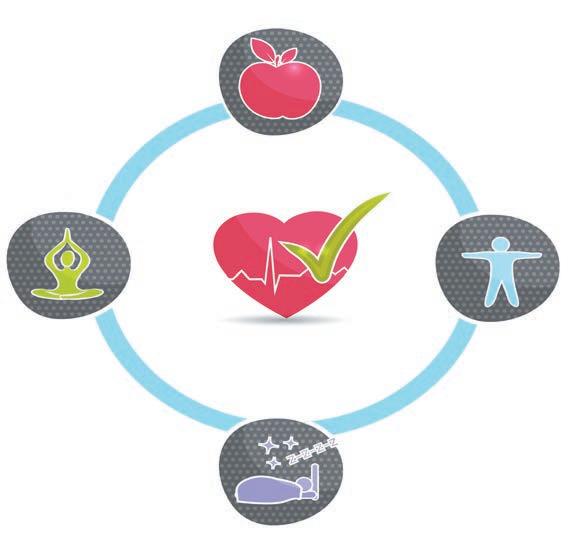


To advertise with Natural Awakenings or request a media kit, please email PhoenixAds@NaturalAZ.com Deadline for ads: the 10th of the month.

Go to NaturalAZ.com/pages/contact to inquire about editorial opportunities. Deadline for editorial: the 10th of the month.
Calendar events are online only, and can be submitted at NaturalAZ.com/calendar
NATIONAL MARKETS
Advertise your products or services in multiple markets! Natural Awakenings Publishing Corp. is a growing franchised family of locally owned magazines serving communities since 1994. To place your ad in other markets call 239-206-2000. For franchising opportunities call 239-206-2000 or email NaturalAwakenings@KnoWEwell.com.
PHOENIX & NORTHERN ARIZONA EDITION
PUBLISHER
Tracy Patterson, BSc, MES
DESIGN & PRODUCTION Vegetorium, LLC
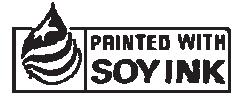
COPY EDITOR
Sara Gurgen
DIGITAL PLATFORMS Hass Solutions Locable
CONTACT US
Natural Awakenings – Phoenix 17470 N Pacesetter Way Scottsdale, AZ 85255 Tracy@NaturalAZ.com NaturalAZ.com

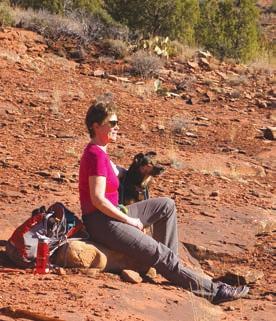
CEO Kimberly B. Whittle COO/Franchise Sales Joe Dunne Asst. Director of Ops Heather Gibbs Layout Designer Gabrielle W-Perillo Financial Manager Yolanda Shebert Digital Content Director Rachael Oppy National Advertising Lisa Doyle-Mitchell
CONTACT US P.O. Box 154 Far Hills, NJ 07934 Ph: 239.206.2000

NaturalAwakenings@KnoWEwell.com
© 2023 by Natural Awakenings. All rights reserved. Although some parts of this publication may be reproduced and reprinted, we require that prior permission be obtained in writing.
Natural Awakenings is a free publication distributed locally and is supported by our advertisers. Please contact us to find a location near you.
We do not necessarily endorse the views expressed in the articles and advertisements, nor are we responsible for the products and services advertised. Check with a healthcare professional regarding the appropriate use of any treatment.
The article in this month’s Healthy Kids section, on page 32, made me think back to when I started ingredient checking. I have examined every box, bottle and package I’ve picked up at the store since I can remember, and all I can say is, wow, have things changed over the years.
I recall as a teenager in the 1970s, looking at boxes of cereal, like Kellogg’s Corn Flakes and Rice Krispies, and they didn’t contain any sugar; we actually added it if we so desired. Now, those two cereals, and almost every other one, come with refined sugar (or high-fructose corn syrup). On top of that, when I used to eat corn flakes I wasn’t worried that the corn was genetically modified—I didn’t even know what that was!
I have never used a lot of condiments, but ketchup and chili sauce are two that I enjoy from time to time. They used to be pretty basic, with no bad ingredients to speak of. Not so anymore! I don’t know when they started sneaking in “our friend” high-fructose corn syrup, but it came as a shock to me one day when I tasted the chili sauce and thought, “Hmmm, that tastes sickly sweet,” and when I looked at the ingredients, there it was… The good news is that some of the health food stores carry ketchup and chili brands that are quite tasty, so I don’t have to abandon my favorites entirely.
And my favorite crazy ingredient example of all time: table salt. Before I started using Himalayan sea salt, I still used a little regular table salt. One day, I was casually looking at the ingredients on the box; I mean, what could possibly be in table salt besides salt? I had to take a closer look to make sure my mind wasn’t playing tricks on me, but there it was, sugar listed as an ingredient in my table salt!
What I’ve learned is that we have to be vigilant about checking ingredients, as they seem to change on a regular basis. It’s not sufficient to check once and deem a product okay; it needs to be examined periodically to make sure a not-so-nice ingredient hasn’t been snuck into the mix. And it only makes sense to instill this practice in our children—a great habit to develop at an early age during their growth, and one they will thank us for later.
Please note that all deadlines (advertising and editorial) are the 10th of the month prior to the edition being published. For example, February 10 is the deadline for all March edition submissions.


Add maternal mental health benefits to the well-documented physical advantages that breastfeeding offers to moms and their infants. A systematic review published in the Journal of Women’s Health found that breastfeeding was associated with overall improved maternal mental health outcomes. A majority of the studies concluded that breastfeeding was connected to fewer mental health symptoms. Thirty-six of the 55 articles reported significant relationships between breastfeeding and reduced symptoms of postpartum depression and anxiety. Notably, when breastfeeding challenges arose or when the actual experience of breastfeeding didn’t meet expectations, five studies reported negative mental health symptoms.
The researchers suggest that breastfeeding may have protective effects on mental health due to the release of oxytocin—also known as the love hormone—which is associated with decreased maternal stress levels and anxiety. This suggests that breastfeeding may have immediate, short-term effects on maternal mood. Further research is needed to help provide better personalized breastfeeding and mental health counseling to moms.

A study published in BMJ Open evaluated the use of zinc for the prevention or treatment of acute viral respiratory tract infections (RTI) in adults.
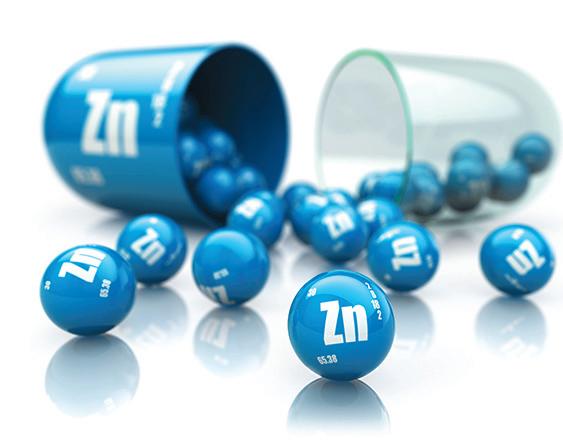
As a treatment for colds and flu, zinc reduced symptoms by two days, compared to the placebo. The researchers surmised that of 100 people with upper respiratory infections, 19 of them recovered by day seven as a result of the zinc treatment. Symptom severity appeared to be lower for those treated with zinc—with improvements seen by day three. Those taking zinc experienced an 87 percent lower risk of developing severe symptoms.
In terms of the prevention of colds and flu-like illness, taking zinc was found to have a modest effect compared to the placebo, with one out of 20 infections prevented. Preventive effects were most significant in reducing severe symptoms. Overall, there was evidence suggesting zinc might prevent RTI symptoms and shorten its duration. Researchers were unable to clearly ascertain the efficacy of different dosages and delivery (oral or nasal spray).
Weighted blankets may be a non-drug option to help ease conditions like insomnia and anxiety by allowing the body to release more melatonin (a hormone that promotes sleep) at bedtime.

In a new study published in the Journal of Sleep Research, researchers from Uppsala University in Sweden measured the amount of melatonin, oxytocin and cortisol in the saliva of subjects after sleeping with either a light blanket or a weighted blanket. They found that using a weighted blanket helped naturally increase production of melatonin by 32 percent. There were no significant changes in the levels of oxytocin, cortisol or sympathetic nervous system activity.
Wellness is the complete integration of body, mind and spirit—the realization that everything we do, think, feel and believe has an effect on our state of well-being.
~Greg Anderson Maksym Yemelyanov/AdobeStock.com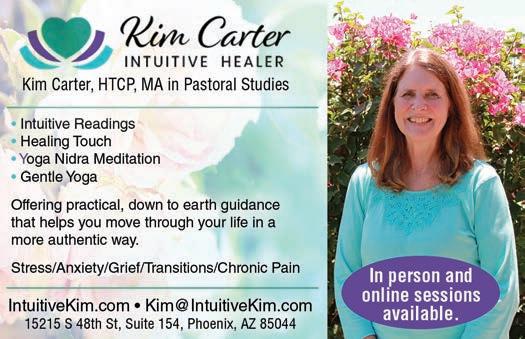





journalists. It’s the best of both worlds,” says Whittle.
PUBLISHING CORPORATIONKnoWEwell, P.B.C., the Regenerative Whole Health benefits and services company, acquired Natural Awakenings Publishing Corporation in December, 2022. “This is a transformational moment for both companies. Readers and consumers looking for trusted knowledge and education related to whole health, sustainable green living and community connections, locally and globally, will surely benefit from this collaboration,” says Kimberly Whittle, CEO of both companies.
Whittle is quick to celebrate the visionary behind Natural Awakenings, which has had an almost 30-year run across American cities, saying, “I am thankful for the tremendous leadership, vision and spirit that Natural Awakenings founder Sharon
Bruckman instilled in this great publication—which I have been reading, enjoying and benefitting from for many years—and I look forward to continuing her legacy as part of the KnoWEwell family.”
Natural Awakenings is—and will continue to be—a franchise with scores of publishers in different markets. “As a franchisee, each publisher manages their own magazine, collaborating with local businesses and producing hyperlocal news reporting and feature stories about people and events in their hometowns. Because they’re right there, they are wellequipped to connect readers with the best local resources. Publishers also are able to offer their readers national articles that are produced by a team of professional
KnoWEwell operates the Regenerative Whole Health Hub, a digital ecosystem, community and marketplace that centralizes global health and well-being knowledge, resources and connections. With a mission to transform health care, it is connecting the dots between regenerative organic agriculture, lifestyle choices, social issues and environmental solutions to inspire and empower individuals to prevent harm, address the root causes of chronic disease and achieve “WELLthier Living”.
KnoWEwell’s acquisition will have minimal impact on local magazine operations. “Moving forward, we’re looking for ways that the two companies can complement each other and also support our publishers at each location in their quest to offer the best content,” Whittle says. “We’re growing a movement as we share knowledge, celebrate healing success stories, provide access to evidence-based resources and create meaningful connections while helping today’s consumers, whole-health providers, mission-aligned nonprofits, businesses and advertisers thrive. Together, we’re addressing global, local and personal issues—the nexus for consumer consciousness, healing and hope.”
The U.S. Department of Energy recently announced the achievement of fusion ignition at Lawrence Livermore National Laboratory (LLNL). This is a major scientific breakthrough decades and billions of dollars in the making, paving the way for us to be able to produce clean fusion energy. Fusion power is considered a game-changer because it would allow us to produce electricity with no carbon footprint or radioactive waste, using fewer resources than it takes to harness solar and wind power.
On December 5, 2022, the LLNL team conducted the first controlled fusion experiment in history to reach what is known as “scientific energy breakeven”, meaning that it produced more energy from fusion than the laser energy used to drive it. Merely a theory until now, fusion combines two light nuclei to form a single heavier nucleus, releasing a large amount of energy. To achieve this milestone, LLNL built a series of powerful laser systems housed in a facility the size of a sports stadium. The lasers create temperatures and pressures comparable to cores of stars and giant planets.
There are still enormous challenges to be tackled in the decades ahead. The first is to develop machinery capable of affordably turning the reaction into electricity without destroying the machinery in the process. The hope is to address these challenges in time to have a positive impact on climate change.
The United Nations designated 2021 to 2030 the Decade on Ecosystem Restoration to prevent, halt and reverse the degradation of ecosystems on every continent and in every ocean.
To that end, the European Union and 26 nations, along with donor support, recently pledged $16 billion to protect, restore and sustainably manage forests. A significant portion of the monies will be spent on reforestation.
Many reforestation projects focus on the number of trees planted, with less attention to how well they survive, how diverse the resulting forests are or how much carbon they store. A study of data from 176 reforestation sites found that on average only 44 percent of newly planted trees last more than five years, with some sites reporting a sapling survival rate of less than 20 percent.
Several studies have explored ways to improve survival rates. Promising measures include planting near mature trees, fencing out cattle, improving soil conditions, planting native species first to pave the way for other tree species and involving local people to support reforestation efforts.


Climate change has spurred researchers and companies to develop fuels with zero carbon emissions. A simple solution is hydrogen because it burns without carbon emissions and is seemingly everywhere—under our feet and in every glass of water. The challenge is obtaining a reliable, safe and sustainable volume of hydrogen at a reasonable cost. There are several methods used today to produce pure hydrogen in large quantities. Most hydrogen is a byproduct of natural gas or coal gasification.
Cemvita Factory, a Texas biotech firm, field-tested a new method of hydrogen production in July, 2022, by injecting a propriety combination of bacteria and nutrients into a depleted oil well. Once inside, the microbes broke down the oil dregs to generate hydrogen and CO2. Cemvita Factory estimates there are more than 1,000 depleted oil wells in the United States that are suitable for their microbial treatment. While hydrogen production using depleted oil wells is getting some interest and attention, it still appears to be at a relatively early stage of development. One challenge faced by Cemvita Factory and other innovators in this area is how to prevent the CO2 from leaking into the atmosphere and contributing to climate change. Methods to capture, store or neutralize the CO2 byproduct will need to be developed.

Dispersed throughout the tropical and subtropical waters of the Indian, Pacific and Atlantic oceans, the hawksbill sea turtle helps maintain high coral cover on reefs by removing invasive prey. Their ornate, beautifully patterned shells make them a favorite attraction for snorkelers and divers around the world. But those beautiful shells also make them a target for illegal harvesting to be carved into combs, jewelry and other trinkets.
According to the International Union for Conservation of Nature, the population of hawksbill turtles has declined by 84 to 87 percent over the last three generations, and their numbers continue to fall. Illegal poaching is not the only threat facing these turtles. Excessive hunting, loss of coral reef habitats due to warming oceans and acidification, light pollution in nesting areas due to development, marine pollution and fatal run-ins with commercial fishing have contributed to their decline.
Conservation efforts are underway in places like Australia and the Caribbean, including working with commercial fishers to develop sustainable, turtle-friendly fishing methods. Laws are in place in many parts of the world to deter and prosecute the illegal trade of turtle products. Consumers can do their part by learning to identify, avoid and report hawskbill shell products. For tips, check out this video by Travel for Wildlife at Tinyurl.com/ HawksbillHelp.
The Summit Lighthouse with spiritual educator Rosalinda Siciliano is hosting a free workshop from 1:30 to 3 p.m. on February 26 in Phoenix as well as via zoom that will explore practical ways to use geometric, nature-derived thought forms to transform one’s life, both personal and planetary.
Receiving a greater creative power and control of one’s mind would be an asset. Some individuals use vision boards to make a picture to help them realize projects and goals. Thought forms can be used to expand one’s mind to imagine, to heal, to reach goals, and to positively control emotions.
Here are four keys that work together to expand an individual’s lower and higher consciousness using thought forms. This practice develops increased sensitivity in analysis of conditions, things and people. One’s inner guide becomes more prominent in personal awareness.


1Use thought forms that relate to geometry; the object or shape must be based in reality, such as a circle, trapezoid, square, chalice, etc. Begin with a small shape, such as a cylinder the size of an oatmeal box or smaller, and then expand it to envelop the whole body. The mind has the power of expansion. It takes practice as co-creator with God.
2Work with color. Embellish the thought form with beautiful color drawn mentally within the object. Visit SummitUniversityPress.com/creative-thought-forms to see examples.
3Give the visualization a tone. Endow the thought creation with a musical tone, such as high C, and picture now a solid object.
4First, purify personal consciousness with the violet flame, a spiritual light brought here by legendary spiritual master Saint Germain. Practice begins with prayer and using violet flame mantras (VioletFlame.com). The violet flame is a holy spirit energy. Each person has a direct connection to Christ, one’s inner guide (middle figure) in the chart of the divine self—the highest thought form; it shows one’s own relationship to God (top figure).
New Age spiritual author Mark Prophet recommends doing this only for five minutes twice a day. See the chart of the divine self for a larger alchemy. See more tips in the book Creative Thought Forms, written by his wife, Elizabeth Clare Prophet.
Location: Via Zoom and in person at 4105 N. 20th St., Ste. 115. To register, visit bit.ly/3Qy01tO. To connect with Rosalinda Siciliano—an educator for all ages, who holds two international Montessori diplomas and is a graduate of Summit University, where science and religion meet—email WhiteLight@q.com. See ad, page 14.
There are many egg choices in the grocery store with different labels— cage-free, free-range, pasture-raised, organic. Here is what these terms mean.
Cage-free eggs are defined by the U.S. Department of Agriculture (USDA) as eggs laid by hens that are able to roam vertically and horizontally in indoor spaces while having access to fresh food and water. Although this method of egg production is considered to be more humane than the longtime standard of battery cages, some cage-free farms may restrict outdoor grazing, and their hens’ nutrition may not be as good as that of hens allowed outside.
Free-range hens follow the same rules as cage-free, with the added requirement of having access to the outdoors during their laying cycle. How much time the hens are permitted to spend outside is open to interpretation, although some animal welfare groups define it as at least six hours per day of outdoor access with at least two square feet of outdoor space per bird.
This term isn’t defined by the USDA, but if eggs come with a third-party animal welfare certification seal, more robust standards of care have been applied. Certified Humane and American Humane Certified both expect pasture-raised, egg-laying hens to have at least 108 square feet of pasture with live vegetation, and for those fields to be rotated so that fresh vegetation is always available. Having access to the outdoors year-round means they must also have access to a barn for protection from predators. Pasture-raised (and organic eggs described below) often have darker, yellower yolks and contain less cholesterol, which may be due to the continuous access to live vegetation and because they have more omega-3 fatty acids.
Organic egg-laying hens must be provided with 100 percent organic feed without the use of pesticides, herbicides or fertilizers. They must also be able to graze outside for at least 120 days per year and are given antibiotics only in the event of an infection.




Local or locally produced eggs must originate less than 400 miles from the processing facility or within the state the eggs originated from and were processed in.
Vegetarian fed ensures that no animal byproducts were used to feed the hens. Grass fed is not defined by the USDA.
No hormones is a misleading term, as the USDA has banned the use of hormones, and all eggs are hormone-free.
Getting a good night’s sleep is undoubtedly a key component of good health. That's why it is unfortunate that the sleep quality of Americans has steadily declined over the years. This is due to a number of factors, such as poor sleep hygiene (the use of electronic devices and alcohol/food consumption before bedtime) and medical conditions, such as sleep-disordered breathing.
We used to think getting seven to eight hours of sleep a night was ideal. While that is still true, it turns out quality is just as important as quantity.
After having administered hundreds of home sleep studies, it has been interesting to observe that while people may be sleeping for the required length of time, they still end up waking up exhausted. Why is that? Well, even though these patients are asleep, they are not reaching the proper level of sleep to get the full benefits. Think of sleep like food. Look at the two plates of food in the images below; they are completely different in nutritional value. The same is true for sleep!
problematic. We tend to think sleep apnea only affects overweight, middle-aged men with necks like NFL linebackers. That’s because in the conventional medical community, diagnosis for sleep apnea is made using the apnea-hypopnea index, which measures how many times an hour you stop breathing for more than 10 seconds. When things get bad enough, health insurance pays for a continuous positive airway pressure (CPAP) machine.
The problem is, there are numerous milder forms of sleep apnea (such as upper airway resistance syndrome and inspiratory flow limited breathing) that make up a host of conditions known as sleep-disordered breathing. In those cases, the body still has the ability to compensate for an obstructed airway. Since oxygen is a huge priority, our bodies will do whatever is necessary to ensure an adequate supply. There is, however, a price to pay for doing so.
In one scenario, micro-arousals occur (measured in sleep studies as respiratory effort-related arousals) in which you wake up just enough to keep breathing, but not quite enough to fully wake up. This is problematic, because even though you are asleep, you never get into deep or REM sleep and therefore do not get the benefits of sleeping.
The other scenario is even worse! Even slight resistance to breathing (like snoring or making any sound during breathing), puts the autonomic nervous system into “fight-or-flight” mode. Not only is sleep quality compromised, but cortisol levels are also elevated. Studies have now shown this to contribute to a host of conditions from Alzheimer’s and diabetes to high blood pressure and unexplained weight gain.
Sleep is like food, which plate resembles yours?


The first part of the night generally consists of a deeper state of sleep. During this period, our body temperature drops, our heart rate and breathing slow, and our muscles relax. This allows for physical regeneration of our body. Failure to reach this level of sleep results in increased inflammation and reduced immune function. The result? A myriad of physical ailments. In fact, recent studies have linked breathing-induced sleep disturbances to fibromyalgia and even cancer!
The second part of the night consists of a lighter level of sleep known as rapid eye movement (REM). Restorative sleep during this time of night (when we dream) has been shown to facilitate learning, improve memory and enhance emotional health. Neurotransmitters and stress hormones are balanced during this time, and failure to reach this level of sleep has been linked to an increase in anxiety, phobias and depression.
While it is relatively easy to make changes to your sleep hygiene, dealing with a nighttime breathing condition is much more
So how do you know if you are getting the quality sleep you need? One way is to use a sleep tracker. Even though they lack the accuracy of a home sleep study, devices such as the Ōura ring, WHOOP band, Fitbit and Apple Watch are excellent tools to monitor your sleep. The second is based on symptoms. In deep sleep, our bodies produce antidiuretic hormone, which stops the production of urine. Chances are if you are getting up more than once a night to urinate, it’s because you are not reaching that desired state of deep sleep. Another good indicator of sleep quality is dreaming. The majority of patients in our practice who are being treated for sleep-disordered breathing, report sleeping through the night and a dramatic increase in dreaming. I love to hear that, because it tells me they are now getting the quality sleep they need.
Fortunately, technology exists now to not only quickly and accurately diagnose conditions of the airway, but also to treat the root cause!
Dr. Ingo Mahn is a 1985 graduate of Marquette University School of Dentistry. He is an accredited member of the IAOMT (International Academy of Oral Medicine and Toxicology) and earned a doctorate in Integrative Medicine from Capital University, in Georgetown. He is the founder of Natural Dental Partners (602-775-5120), a health-centered dental practice in North Phoenix that treats airway-related problems. Visit ABreathOfHealth.com for more information and download a free copy of his book. See ad, pages 5 and 25.

When it comes to preventing cardiovascular diseases, lifestyle changes such as diet and exercise are often mentioned. But a deeper dive into heart health shows other factors such as sleep, stress management and proper screenings are just as important.

Dr. Randi For aker is a professor of medicine within the Division of General Medical Sciences at Washington University in St. Louis (WUSTL), and the Deputy Director for WUSTL’s Institute for Informatics. She helped co-author the American Heart Association’s (AHA) Life’s Essential 8, a prescription of eight lifestyle metrics for cardiovascular health. They include modifiable risk factors such as diet, physical activity, nicotine exposure, sleep
duration, body mass index, blood lipids, blood glucose and blood pressure.
Last June, the AHA added sleep to their lifestyle recommendations. “Poor sleep has been something we have suspected as a contributor to cardiovascular health for some time,” Foraker says. “Sleep has been identified recently as a risk factor for cardiovascular disease and other chronic diseases. Interrupted sleep is a problem, because our body isn’t able to rebuild and recharge if we don’t have adequate sleep. That’s a recent finding, and the evidence around that is building.”
n addition, research into how sleep patterns affect heart health is ongoing. Experts are looking at when people are sleeping, and if it’s broken into three- or four-hour increments. The demands of one’s occupation may lead to sleeping during the day instead of at night, or broken sleep that may or may not lead to a total of eight hours of sleep.

“Not managing stress well can be linked to insulin resistance, gut issues, high blood pressure and inflammation, which directly contribute to heart disease,” says Charlotte Nussbaum, M.D., a functional medicine practitioner based in Medford, New Jersey. “That’s a lifestyle factor that people need to address—and it can be the hardest one to address. Even if you’re dialed in to a healthy diet and exercise routines, you’re not going to keep yourself healthy if you have unresolved stress issues.”

Nussbaum further notes that unaddressed childhood traumas can lead to unhealthy stress management techniques. She encourages people to consult with a therapist or other practitioner to work through childhood traumas. Try to identify and eliminate the stressor. If a job is causing stress, we can’t always change jobs, but using techniques such as yoga, meditation and mindfulness can help.
She also recommends bodywork and movement, breathing techniques, biofeedback and going outdoors and into nature as effective stress relieving techniques.
Foraker notes that the Life’s Essential 8 framework has specifically called out mental health and social determinants of health. These underlying factors can be barriers to achieving ideal cardiovascular health. “Mental health can impact depression and be a proxy for nicotine addiction and poor diet,” she says.
Social determinants may include living in a food desert without access to healthy foods. Some people may not be able to achieve physical fitness because they might live in a high crime area, preventing them from being physically active outdoors. “Social determinants of health are often cost prohibitive to achieving health goals,” Foraker reiterates.
Nationwide, nonprofits such as The Food Trust are helping to bring nutritious food to low-income communities. The National Youth Sports Strategy, an initiative of the U.S. Department of Health and Human Services, strives to expand children’s participation in youth sports and encourage regular physical activity.
Nussbaum observes that while much attention is placed on lowering fat and cholesterol for a healthier heart, what is more important is choosing fats that don’t oxidize easily. When low-density lipoprotein (LDL) is oxidized, it can lead to atherosclerosis, the buildup of plaque on the artery walls.
“Seed oils like canola oil, safflower oil, sunflower oil or corn oil have been promoted as heart healthy, but those are very easily oxidized because they contain linoleic acid, an inflammatory omega-6 fatty acid that can contribute to heart disease,” Nussbaum says. “While omega-6 is an essential fatty acid, we only need a small amount in our diets. Our modern diet has become very high in omega-6.”
Nussbaum advises increasing omega-3 intake to balance the omega-3s/omega-6 ratio. Cold water, fatty fish that’s low in mercury, such as salmon, along with shellfish, are good sources of omega-3s. For people that don’t eat seafood, marine algae provide omega-3s.
Polyphenols are plant-based foods that boost heart health and immunity. Polyphenol-rich foods include green tea, citrus fruits, hibiscus tea and turmeric. Nussbaum adds that organ meats such as liver are high in antioxidants such as retinol and vitamin A.
Red meat has gotten a bad rap, but Nussbaum notes how meat is sourced makes a difference. The nutritional quality of a fast-food burger is much different than a cut of beef from grassfed cows that are sustainably raised; the latter having a very different nutrition profile, along with omega-3s.
Nussbaum cautions that consuming a low-fat diet may not lower risk of heart disease because many low-fat diets substitute fat with carbohydrates. A high-carbohydrate diet can lead to obesity and insulin resistance, which are risk factors for heart disease.
It can be intimidating to start a workout regimen, especially if time is limited. “What’s more important is not being sedentary and finding ways to keep moving,” Nussbaum reassures. “Even if you
fizkes/123rf.com
The American Heart Association confirms that practicing mindfulness and meditation may help manage stress and high blood pressure, improve sleep and help us feel more balanced and connected, which can help lower the risk of heart disease.

Meditation can be as simple as sitting quietly in a calm place and focusing on breath. Other types include relaxation, Zen, transcendental and mantra, and mindfulness-based stress reduction.
have a desk job, there are ways to incorporate short bursts of movement into your day. Walking can be helpful.”
She adds that high-intensity interval training—short bursts of intense exercise alternated with low-intensity recovery periods—can be effective for those with limited time. “Some of those workouts are only five to 10 minutes long but can have just as much benefit as a 90-minute cardiovascular workout.”

Dr. Yale (Yoel) R. Smith is a Florida-based physician who is triple board-certified and an Advanced Fellow in Anti-Aging Metabolic and Functional Medicine. “There are millions of people walking around with severe cardiac disease that do not even know it, because heart attacks and death from an acute coronary syndrome can kill someone without warning,” he cautions. “Thus, preventing such an event with specialized testing can allow people to live long lives with loved ones.”
mith emphasizes the importance of a complete lipid profile. “I see many patients that come to me with incomplete lipid profiles,” he notes. They do
not include sensitive biomarkers that go beyond just total cholesterol, LDL, highdensity lipoprotein and triglycerides.
There’s a misconception that if one’s cholesterol is within normal range, they need not worry about heart disease. “But someone could have ‘unstable plaque’ just waiting to burst in a coronary artery that kills the patient,” Smith explains. “When an unstable plaque ruptures in a major vessel, the body senses it as bleeding and sends clotting factors to stop the bleeding, thus creating the heart attack and death. We can look for this with cutting-edge testing.”
Such testing includes Cleerly, which uses artificial intelligence to look within the coronary arteries. It provides actual visualization of the patients’ vessels and pinpoints locations of stenotic lesions, total plaque volume and unstable plaque locations. “This is revolutionary and allows me to provide information to the patient and the interventional cardiologist vital information before catheterization,” Smith says.
The Protein Unstable Lesion Signature test looks for cellular markers for highrisk patients and determines risk for plaque rupture. The Vibrant Health CardiaX allows doctors to look at 22 different genes that can contribute to various heart disease issues.
“Family history is a look into the future of your chance of developing heart diseases,” Smith shares. “The genetics of a patient’s family is quite important, and genes can jump a generation. Thus, the patient could have their grandfather’s or grandmother’s genes that can put them at risk and lead to an early death.”
There are natural ways to control and reverse heart disease, Smith reiterates, but he cautions against over-the-counter, unregulated supplements marketed toward improving heart health. A comprehensive workup and cardiovascular health plan should be monitored by a qualified medical doctor.
“Meditation and massage are beneficial to lower stress,” Smith concurs. “Stress and high cortisol levels create a pathway to heart disease, elevated blood pressure and other issues. Thus, anything that can lower stress and create a happy lifestyle will help with heart health.”
For more information, visit Tinyurl.com/55nuk9dm.

 by Brooke Goode
by Brooke Goode
In 1994, the same year Jeff Bezos founded Amazon and Deepak Chopra laid the first bricks on his path to enlightenment, Sharon Bruckman created Natural Awakenings magazine. Each a visionary. Each ahead of their time.
By the late 1990s Americans had developed a voracious appetite for well-researched, practical information about the latest natural approaches to nutrition, fitness, personal growth and sustainable living. The Natural Awakenings franchise was born, expanding into the largest franchise publishing network in the health and wellness industry.
As the magazine’s 25th anniversary issue, published in 2019, explained, Natural Awakenings was woven from the threads of grit, inspiration and serendipity, creating a tapestry of health, healing and mindfulness. In an interview appearing in that issue, Bruckman clarified her purpose, saying, “The why that has been keeping me ‘on purpose’ can be found in the same mission statement that inspired me to create Natural Awakenings: to inspire and empower people to awaken to their highest potential, so together we can create a world
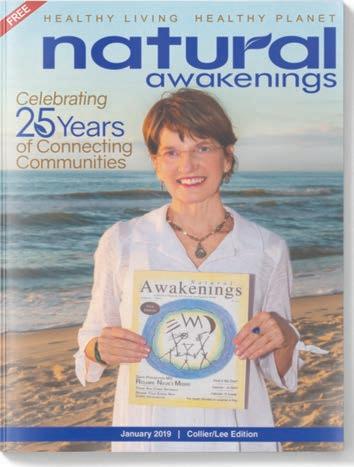
that works for all living things.”
The world’s delicate ecosystem, now in crisis, was also in need of help. “The critical issues we now address in Natural Awakenings like genetically modified foods and climate change—were just emerging in serious public discourse then, but have since grown in urgency,” Bruckman said. “The good news is that in the past 25 years, viable solutions in renewable technologies, organic farming methods and holistic healthcare practices have made great strides; now they just have to be implemented on grander scale.”

Shortly after the 25th anniversary issue was published, Joe Dunne, Natural Awakenings’ COO, had a serendipitous meeting with Kimberly Whittle, founder and CEO of KnoWEwell. One conversation later, he was certain that Whittle and Bruckman should meet, given their shared vision and mission. Dunne describes KnoWEwell’s online Regenerative Whole Health Hub as “WebMD, NEJM [New England Journal of Medicine], Match.com, Home Advisor, LinkedIn, Facebook, Amazon, Quora, Medium and Apple News all rolled into one for health.” A week later, Whittle was on a plane to Florida to visit Bruckman at her home. It was the start of a providential relationship between two visionaries determined to bring natural healing, health and hope to individuals and families.
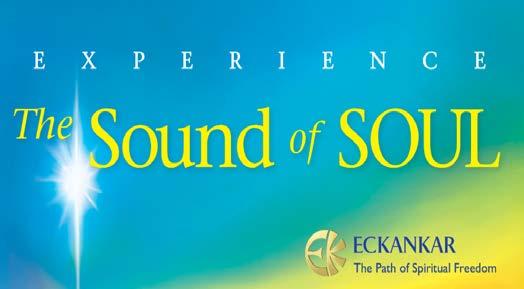
A decade earlier, in 2009, Whittle was driven by a series of family health crises to embark on a search for solutions. Deep diving into evidence-based research, she traveled the country to multiple integrative and functional medicine practitioner conferences. “I was blessed to find tremendous success in the prevention and healing of chronic conditions through what today is defined as Regenerative Whole Health, a broad spectrum of global healing approaches and therapies that consider the whole person—mind, body and spirit— connecting the dots between soil, food, lifestyle choices, planet

and personal health to help prevent and address the root causes of chronic diseases,” she explains. “I began as a mom on a mission. As I grew into my family’s healer, and then a health and well-being resource for my friends, I felt a deep yearning to go beyond my community and help more people.”
Combining her entrepreneurial spirit, professional experiences, passion and purpose, Whittle formed KnoWEwell as a force for good in the world, to pay it forward and make it easier for others facing their own health crises, and to pay it back to the professional organizations and providers that helped her family heal. Much like Natural Awakenings, KnoWEwell’s mission is to transform health care by inspiring and empowering individuals with the knowledge, resources and community to proactively prevent harm, address chronic diseases and create “WELLthier Living” for themselves, their families, humanity and the planet.
Last December, KnoWEwell acquired Natural Awakenings, creating an integrated ecosystem that is committed to community, spanning the information gaps, providing immersive multimedia educational experiences and fostering trusted connections locally and globally. Together, these two companies are set to be the solution for consciousness, healing and hope.
Individually and collectively, we are facing unprecedented challenges. Human and planetary health are in crisis, and they are inextricably linked. According to the World Health Organization, climate change is the biggest global health threat confronting humanity.
The Food and Agriculture Organization of the United Nations estimates that 33 percent of the Earth’s soils are already degraded, and more than 90 percent could become degraded by 2050. Soil erosion decreases agriculture productivity and contributes to a host of environmental threats. It can take up to 1,000 years to produce just two to three centimeters of soil.
While gene-edited crops are being promoted by the world’s largest chemical companies as “giving mother nature a boost,” Jeffrey Smith, founder of the Institute for Responsible Technology, warns,
“With gene editing techniques, such as CRISPR, nature could be permanently corrupted by countless GMOs, and our food supply— including organic—could be overrun.”

Meanwhile, six in 10 adults and more than half of all children have a chronic health condition. The problem, Whittle believes, is that while our conventional medical system excels at acute care for an injury or a heart attack, it was never designed to treat chronic conditions, focusing more on the symptoms than the root cause of disease. Studies show there is a roughly 17-year lag between new research and mainstream health and medicine practices.


Evidence-based research is proving that while our DNA may be our ancestry, it is not necessarily our destiny. According to Dr. Jeffrey Bland, the father of functional medicine, “Our gene expression is altered by numerous influences including environment, lifestyle, diet, activity patterns, psycho-social-spiritual factors and stress. These lifestyle choices and environmental exposures can push us toward (or away from) disease by turning on—or off—certain genes.” Ninety percent of the risks of chronic disease are due to non-genetic factors, and with the right knowledge and resources, individuals can change their lifestyle and environment to prevent and reverse chronic health conditions.
Rodale Institute, a leader in organic farming education and research, points to the importance of farming methods in addressing the health and planet crises. According to the organization, “Hope is right below our feet. Healthier soil grows healthier plants, and healthier plants are more nutritious plants. In our work at Rodale Institute, we’re investigating the links between soil health and human health and proving that organic [farming] can feed the world.”
The good news is that the local Natural Awakenings print magazines, together with KnoWEwell's Regenerative Whole Health Hub, a global digital ecosystem, are forging the paradigm shift. Whittle is honored to be continuing Bruckman’s legacy. “We are kindred spirits; I have the same purpose and unwavering drive that Sharon had founding Natural Awakenings nearly 30 years ago. I am
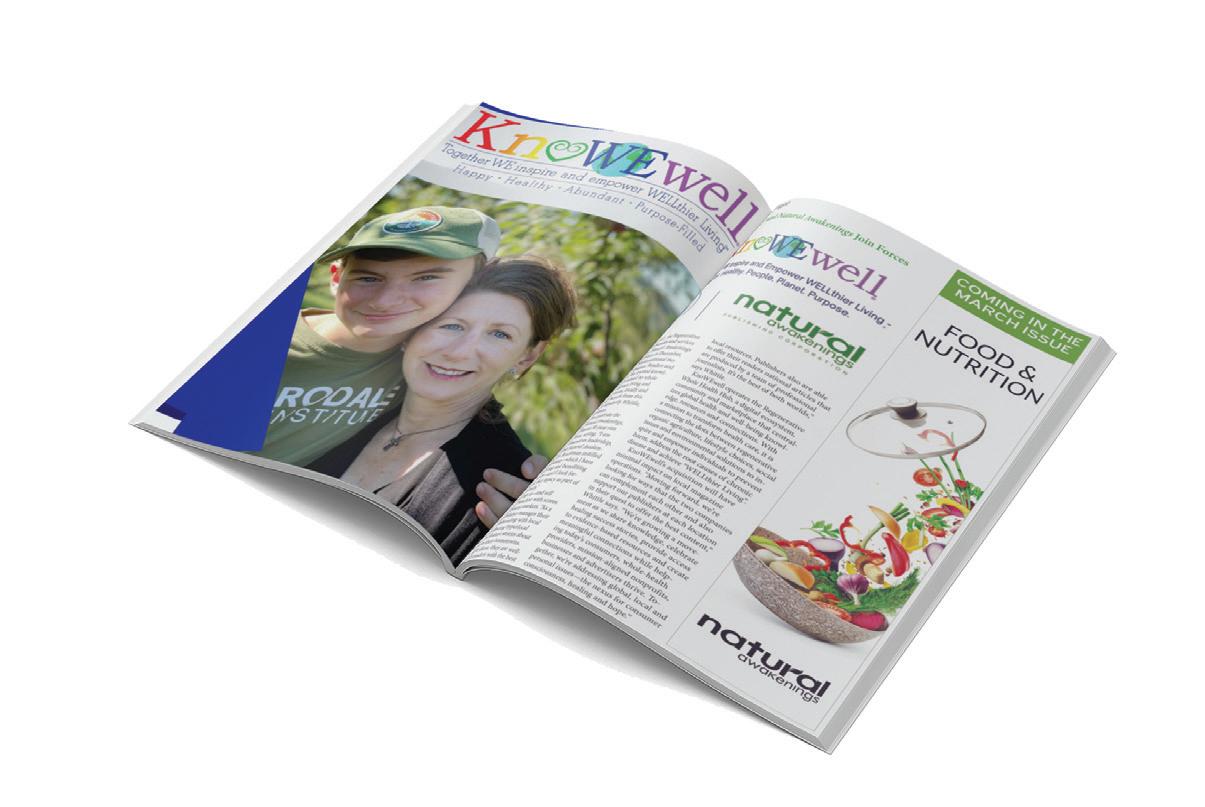
deeply committed to multi-stakeholder collaboration that benefits all—our families, communities and the planet. We will educate to bring consciousness of connections into daily practices and respect for Mother Earth so all can thrive and prosper. Together, we will inspire, empower and achieve a WELLthier Living World.”
Brooke Goode is KnoWEwell’s national editor.
Research by Rodale Institute has confirmed that adoption of regenerative organic farming practices could capture more than 100 percent of current, humancaused emissions of carbon dioxide in the atmosphere. Rodale Institute researchers concluded, “We now know enough to have real hope, and with this hope comes the responsibility to journey down a new path.”

Millennials are leading the way on conscious living, flocking to integrative options and opting for more “natural” care, long advocated by Natural Awakenings. They now constitute the largest sector of the U.S. workforce with annual spending power of $600 billion. Close to 60 percent of millennials research information about health and nutrition online and on social media. This health-conscious generation believes good health is both a personal and social responsibility. They are early adopters of wearable technology and prefer organically grown, locally sourced and ethically raised foods. But consumers of all ages are overwhelmed by information and unverified online sources in the fragmented whole health market.
The World Economic Forum reported in 2021 that health care is undergoing a digital revolution that requires multistakeholder collaboration and the bridging of information gaps by fusing the digital and analog worlds. The 2017 industry white paper “The Rise of Wellcare”, by PricewaterhouseCoopers, concluded that integrated ecosystems for the consumer in the healthcare industry are essential. This paradigm would include products, services, social media, community and environmental activism.
Using light energy through distance healing, your healing process can move forward more smoothly.
“My knee was warm for about 3 full hours after I left. It seemed to heal further after I slept the first couple of nights. While my knee was not healed 100%, it was significantly better and I was able to go on my Montana ski trip the next week.
P.S. Another month after my ski trip my knee has continued to improve.”
Robert, Gainesville, GA
Practicing by donation for nearly 10 years. Questions? Call Bill at 770-990-9191 or visit https://www.distancehealer.me

 by Marlaina Donato
by Marlaina Donato
Jam-packed schedules and answering the demands of everyday life can trip us up and break the spell of even the most solid intimate partnership. With dulled senses, it is easy and all too common to go on autopilot. Like abandoned gardens, heart-unions can become casualties of neglect and the absence of joy.
Mindfulness—awareness and cultivation of the present moment—has been shown to lower blood pressure, reduce anxiety and depression and deepen our appreciation of what we have. Relationships can expand and strengthen when couples practice the art of being in the “now”. A 2021 study involving 1,360 heterosexual couples published in the Journal of Sex & Marital Therapy indicates that gratitude and forgiveness also contribute to satisfaction, both relational and sexual.
“Mindfulness practice comes in many forms: journaling, meditation, mindfulness-based cognitive therapy, tai chi or breathwork, to name just a few. By routinely practicing mindfulness, we are able to deepen our own awareness of what we are feeling and how we want to respond to someone we care about,” explains Moraya Seeger DeGeare, in-house relationship expert for Paired, an app for couples.
Maci Daye, the author of Passion and Presence: A Couple’s Guide to Awakened Intimacy and Mindful Sex says, “Even a few minutes a day of mindfulness practice can rewire the brain, build new habits and help us dis-identify from our limiting beliefs, stories and intense emotions.” This is a critical factor in transcending personal triggers and promoting conflict resolution.
She emphasizes that couples often go into fight-orflight mode because
they feel threatened by their partner’s non-verbal behavior or are triggered by old, painful wounds.
Daye, a licensed professional counselor and certified sex therapist, notes, “Mindful couples are less attached to being ‘right’ and explore their own sensitivities instead of blaming their partners.” Once “awakened intimacy” is put into practice, couples become interested in each other’s perspectives and team up to heal and grow. In addition to formal training, she suggests bringing presence to all aspects of life. “Couples can engage their senses when they hug, touch or hold hands,” Daye explains. “They can pause to look at each other when they say hello and goodbye. They can slow down and taste their food, savoring every bite. These behaviors also make sexual experiences more sensual, intimate and connecting.”
Taking a few moments for eye contact, the brush of a hand or compassionate interaction can strengthen bonds. DeGeare, who is also a couple’s therapist at BFF Therapy, in Beacon, New York, recommends slowing down together to get in sync. “This could be going for a walk, cooking or listening to the same podcast and talking about it later. It helps the body tune into your partner a bit and connect. The time you spend doing this outside of the bedroom will deepen your connection in the bedroom.” She suggests bringing movement like a shared dance or yoga class into the mix to foster connection, as well as setting “dedicated times to check in through the week or month, uninterrupted.”
Daily verbal exchanges beyond the mundane can amplify resonance between two people. “Asking questions is vitally important, as it cultivates curiosity—but not the day-to-day questions, such as, ‘What are you doing today’ or ‘What do you want for dinner?’” says Debbie Lambert, co-author of The Mindful Couple. The Del Mar, California, couples counselor and life coach encourages people to ask, “What scares you today? What is the most important thing that you would like to create today? What was one thing that made you grateful today, and what is one thing that disappointed or frustrated you today? What is one thing I can do for you today? These types of questions scrape the surface of knowing and create intimacy and connection.”
Lambert compares the practice of mindfulness to a beautiful dance—flowing, loving and creative—that can change future generations. “The energy from such a dance extends far beyond the couple,” she says. “It can be felt intimately by anyone in its presence. When parents dance this dance, their children are bathed in a high-vibrating energy. They feel safe and loved. Most importantly, they learn a model for how to be in a loving relationship.”
Marlaina Donato is an author, visionary painter and recording artist. Connect at WildflowerLady.com.
 FROM DEBBIE LAMBERT
FROM DEBBIE LAMBERT
Couples get too familiar with each other over time, and the wonder and curiosity leave the bedroom. To deepen the sexual experience, couples can: n Shift from knowing to curiosity. Ask yourself, “What does my partner need in this moment?” Be in tune with subtle movements and embrace them in the moment, versus thinking this is what my partner likes.
n They say the eyes are the windows to the soul. Eyegazing in bed is a deeply spiritual activity that allows us to connect beyond our normal experiences with each other. n Smile, laugh and embrace the moment with some lightness. When we smile and laugh, we are out of our heads and into our hearts. This is where we want to spend more time in general.
While most couples think they must do more to experience novelty, the best sex results from simply being there and tuning into bodily sensations. Knowing this relieves couples that are exhausted and pressured by the demands of modern life, which have been exceptional lately. They may avoid sex because they fear they must “go all the way”. However, if we are fully present, we can have magical, erotic experiences that are brief and don’t necessarily involve the genitals.
The right food choices don’t just prevent heart disease and help shrink artery plaque, they also nourish and heal the heart. For a healthy ticker, enjoy these five food groups every day.
Fiber is the roughage in vegetables, fruits, beans and nuts, and it is loaded with agebusting nutrients. Eating fiber suppresses appetite, promotes weight loss, improves blood sugar and cholesterol levels, decreases inflammation and feeds a healthy gut microbiome.
The challenge is to get more fiber every day. Too often, people consume fiber from processed grains and flour, and the sugar load that comes with grain fiber has many adverse impacts on heart health. The best option is to enjoy daily fiber from the following sources: three cups of colorful vegetables; two pieces of fruit, such as one cup of berries and one apple; two handfuls of nuts and seeds; and one-half to one cup of beans.

Clinical studies show that enjoying fats from seafood, extravirgin olive oil and nuts decreases the risk of a heart attack and stroke without causing weight gain. Healthy fats improve cholesterol levels, assist with blood sugar control, are critical for the brain, improve hormone balance and reduce inflammation.
Fats enhance the texture of food, adding that smooth, creamy mouth feel to a meal that makes eating a pleasure. Enjoy healthy fats from avocados, seeds and dark chocolate daily.
Raising animals in large-scale conventional operations with cruel living conditions is not just mean, it also produces less nutritious meat that can be loaded with hormones, antibiotics and pesticides. Choose clean protein instead, which does not contain added hormones, pesticides and other toxins. Good sources of protein are organic dairy products and eggs, wild seafood and animal protein that has been grass-fed or organically fed while living on open pasture. Beans are also a great proteinpacked choice that improves blood sugar and cholesterol profiles. They are the most powerful anti-aging food ever tested.
Start with at least four cups of water per day. It doesn’t matter whether it’s flat or sparkling, so long as it’s pure. Pure water can be purchased or made at home or at work with a reverse osmosis filter system.
Except for people that are caffeine sensitive, one to two servings of caffeinated beverages can be enjoyed daily. In moderation, those tea and coffee pigments are good for us.
Don’t forget a fiber- and protein-rich smoothie to stay satisfied and revved up all morning. A balanced and delicious recipe includes one serving of protein powder, frozen organic cherries or blueberries, almond milk and chia seeds.
Take advantage of the option to enjoy wine with dinner—just be sure to limit wine intake to no more than two servings daily.
Avoid any beverage with added sugar or commercial sweeteners. Don’t be fooled into drinking juice; without the fiber, fruit juice is much closer to drinking soda than to eating fruit.
Not only do probiotics help gut function— a healthy gut microbiome decreases inflammation and supports weight control. The latest research reveals that the microbes in the gut have a dramatic impact on the risk for heart disease, as well. Because healthy microbes feed on fiber, eating fiber is good for the gut microbiome, too.
The right gut microbes offer numerous benefits. They lower harmful cholesterol levels, improve blood sugar levels, lower blood pressure to normal levels, assist with weight loss, decrease inflammation and decrease
1 medium eggplant (remove ends and any damaged skin), cut into 1-inch cubes
2 Tbsp extra-virgin olive oil
1 medium sweet onion, diced
½ tsp sea salt
¼ tsp ground black pepper
½ tsp oregano, dried
½ tsp fines herbes (or Italian herb seasonning), dried
3 small zucchini, chopped into ½-inch cubes (about 2½ cups)
2 small yellow squash, chopped into ½-inch cubes (about 2 cups)
2 Tbsp white wine
3 medium tomatoes, chopped (about 2½ cups)
4 medium garlic cloves, minced
1 Tbsp chopped fresh parsley
1 tsp fresh rosemary, diced
1 Tbsp fresh basil, chopped
⅛ tsp paprika or cayenne powder (or to taste)
1 lb firm tofu, cubed, or 15 oz cooked cannellini beans (optional) Fresh herbs for garnish (parsley, basil, and/ or thyme)
This fragrant side dish from southern France is packed with nutrients. It goes well with chicken or fish, and especially a soufflé. To convert this from a side dish to a complete meal, add 1 pound of cubed tofu or 15 ounces of cooked cannellini beans. Can be served hot or cold and usually tastes better when served the next day.
Steam eggplant on the stove top for 6 minutes or microwave in a glass container for 4 minutes. Cook until tender.
Heat a pan on medium heat and add olive oil; add the onion, salt, black pepper, oregano and fines herbes. Sauté for 2 to 3 minutes or until onions are soft and translucent. Add zucchini, yellow squash, eggplant and wine; stir. Cover and heat for 3 to 4 minutes, until the vegetables soften, stirring occasionally. Add the tomatoes, garlic and fresh herbs; cover, reduce heat to low and simmer for 4 to 10 minutes, until squash softens and the flavors blend.
For a touch of heat, add paprika or cayenne pepper. Garnish with fresh herbs.
Excerpted from The 30-Day Heart Tune-Up. Copyright © 2021 Steven Masley, M.D. Used with permission from Little, Brown Spark, New York, NY. All rights reserved.


YIELD: 4 SERVINGS
1 Tbsp extra-virgin olive oil
1 medium onion, chopped
¼ tsp sea salt
1 cup mushrooms, sliced
1 tsp dried Italian herbs (rosemary, thyme, oregano, basil)
¼ tsp ground black pepper
3 large carrots, chopped
1 medium fennel bulb, chopped into ½-inch pieces (or 3 celery stalks)
1 cup red wine
1 medium red bell pepper, chopped
1 cup chopped tomatoes or tomato sauce
2 cups low sodium vegetable or fish broth
1 pound mussels and/or clams in the shell, scrubbed clean
1 pound fresh whitefish, cut into 1-inch pieces (tilapia, cod, snapper, catfish)
½ pound large shrimp, peeled and deveined 8 large sea scallops
½ cup fresh parsley, chopped
Heat a large stew pot over medium-high heat. Add oil, onions, salt, mushrooms, herbs and black pepper; stir for 2 minutes. Add carrots and fennel; cook another 2 minutes. Add wine to deglaze for 30 seconds while stirring. Add bell pepper, tomato sauce and broth; simmer for 15 to 20 minutes.
Meanwhile, unless the seafood is super fresh, soak fish, shrimp and scallops in orange juice or milk for 10 minutes. Rinse and drain when ready to add them to the pot.
Bring another pan with a steamer tray to a boil; add the mussels and/or clams; cook until they open, 5 to 6 minutes. Drain, saving 1 cup of the liquid for later use.
Increase the temperature under the large stew pot to mediumhigh and add the fish, shrimp and scallops. Heat 4 to 5 minutes until shrimp are pink and fish is cooked. Add the drained mussels and clams plus 1 cup of the reserved clam/mussel liquid; simmer another minute.
Ladle stew into bowls and garnish with parsley. This stew is fabulous accompanied with a tossed green salad on the side or as a second course. Be sure to set the table with additional large bowls for discarded shells.
Recipe excerpted from The 30-Day Heart Tune-Up by Steven Masley, M.D. Copyright © 2021 by Steven Masley, M.D. Used with permission of Little, Brown Spark, New York, NY. All rights reserved.



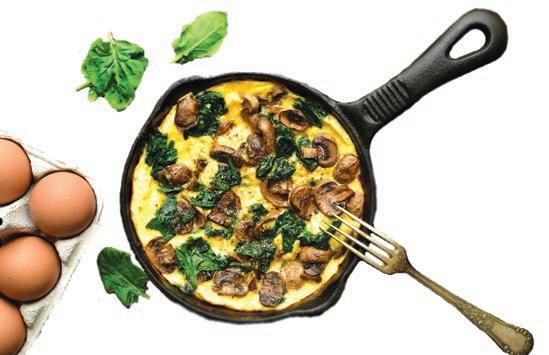
YIELD: 4 TO 6 SERVINGS
½ pound fresh spinach, washed and drained, stems removed, chopped
2 Tbsp extra-virgin olive oil
½ medium sweet onion, finely chopped
2 cups mushrooms, sliced ½ tsp sea salt
1 tsp Italian herb seasoning
2 medium garlic cloves, finely chopped
8 large cage-free, organically fed eggs
2 Tbsp organic, whole fat milk (or sour cream)
½ cup organic Comté (or Gruyère) cheese, grated ¼ cup Parmigiano Reggiano cheese, grated
Preheat oven to 375° F.
Place spinach in a saucepan with ½ cup of water. Cover with a lid and allow to steam on high heat for 5 minutes. Remove from heat and drain; squeeze out excess water. Set aside.
Heat a sauté pan to medium heat; add olive oil, then onion; stir occasionally. After 1 minute, add mushrooms and continue heating for about 3 to 4 minutes until the onion is translucent and the mushrooms
have softened. Add garlic and Italian herbs and heat 1 minute, then remove from heat.
In a large bowl, whisk the eggs and milk together. Stir in the Comté or Gruyère cheese, steamed spinach and sautéed onions with mushrooms.
Grease a pie dish with extra virgin olive oil, then pour the egg and vegetable mixture into the pie dish. Sprinkle Parmigiano Reggiano cheese over the top.
Bake for 25 to 30 minutes, or until it has the texture of custard—trembling and barely set. For a golden crust, turn on the broiler for the last couple minutes of baking, but don’t overbake, or it will get tough. Check it 5 minutes before it’s supposed to be done.
This recipe and photo were excerpted from The Mediterranean Method. ©2019 Steven Masley, M.D. Used with permission of Harmony Books. All rights reserved.
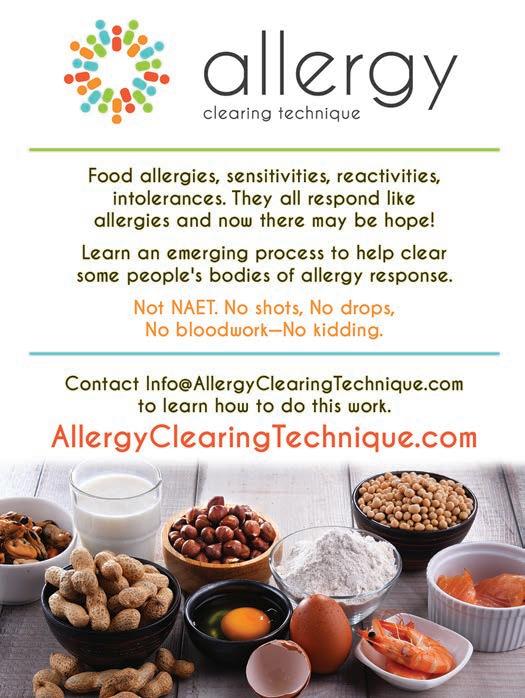
2023 Certification Classes, Workshops & Seminars ... which will you choose, one or ALL? Advanced Formulation weekend: April 29 & 30 Reiki? Sound healing? Buddist Monks? Classes are filling fast! RSVP at (480) 694-9931 or SWHerb.com/classes-and-workshops/
FREE Intro to Herbal seminars: February 5 & 11 5-week Certification Class, starts Sat, March 4 Plant Spirit Medicine evening, April 20th, 6-9 pm
www.SWHerb.com/shop

As guardians of our beloved pets, choosing the best food for them can be a daunting task, with so many options online and in grocery stores, as well as conflicting advice about what is healthiest. For thousands of years, pets were fed human food scraps, and in the last 50 years, as dogs were elevated from being pets to valued members of the family, handing them treats directly from the dinner table became a common practice.
Nevertheless, commercial pet food has become an enormous industry in a relatively short period of time—it has only been around for just over 150 years, according to the Pet Food Institute. Globally, the pet food market was valued at almost $95 billion in 2021 and is expected to continue growing, according to Grand View Research. North
America dominated the market, accounting for a 49.9 percent share of worldwide revenue that year.
The immense popularity of commercial pet food can be attributed to numerous reasons. Socioeconomic factors make buying processed pet food affordable; nutritional science makes it look sophisticated; veterinarians endorse it and marketing agencies persuade guardians that it is the best option. Many pet guardians may be concerned that table scraps are not as healthy for their pet as kibble. As a result, most dogs and cats consume commercial diets, many of which include byproducts from the human food industry.
Kelly Swanson, a University of Illinois professor and the author of a 2018 nutrition study published in the Journal of Animal
Science, told Science Daily, “A lot of companies test for complete and balanced nutrition but don’t go beyond that.” She further noted that her study evaluated certain diets by looking at additional factors: “Would dogs like them? Were they digestible? Would they increase activity?”
Because they are unprocessed and unrefined, pet diets made of whole foods contain more intact nutrients and provide more fiber for digestive health, which can help with constipation, diarrhea or both. According to a 2021 study published in the Journal of Animal Science, some types of fresh, “human-grade” food may be simpler for pets to digest than dry, commercial kibble.

A recent study examined the gut microbiome of pet and stray dogs from South Africa, India and Loas and compared their gut microbiomes to those of dogs that lived 1,000 years ago. The researchers found that the varied diet of the stray dogs of Loas had the most robust microbiome and that it was comparable to the diet consumed by ancient dogs. Like in humans, a healthy and balanced gut microbiome is important for digestion and to fight inflammation.


While there are some foods that pets should avoid, such as alcohol, dairy, chocolate and grapes, many types of meat and vegetables that humans eat can be served to their pets. Because whole-food ingredients like chicken, pork, lamb, beef and chick en eggs are readily available at local grocery stores, it’s easy to get started. The key is ensuring that a pet gets a balance of protein, fat and carbohydrates. There are plenty of homemade pet food recipes available online that consider this balance. The needs of a pet will vary based on species, age, weight and overall health, so consulting with a veterinarian is recommended to keep the pet’s health on track.
n If it is in the budget, choose grass-fed or pasture-raised meats, which have a healthy omega-3 to omega-6 ratio and are anti-inflammatory.
n The diet should include calcium, iron, zinc and other es sential nutrients based on species and individual needs. Consult a veterinarian for guidance.

n Although dogs do not require carbohydrates in their diet, they can digest them. Dogs use dietary carbohydrates to maintain and replace glycogen levels.
n Introducing vegetable fiber—kale, collard greens and fruit such as apples—to a dog’s digestive system helps prevent gas pain.
n Obtain ingredients from organic sources whenever pos sible, because they contain no pesticides or chemicals that could harm a pet’s health.
n Avoid processed foods and artificial ingredients.
n Look for pet foods without preservatives, byproducts, fillers or food dyes.


The Association of American Feed Control Officials (aafco.org/ consumers) offers a wealth of information and guidance regarding commercial pet foods and ingredients. While they do not have a whole foods classification, they do provide information about natural and organic pet foods.
Feeding pets whole food is a great way to help them stay healthy and happy. Make their food at home using fresh ingredients, or look for commercial brands that incorporate whole foods in their products. A pet’s best health starts in the bowl.
Ruth Roberts is an integrative veterinarian and holistic health coach for pets, as well as the creator of The Original CrockPet Diet. Learn more at DrRuthRoberts.com.
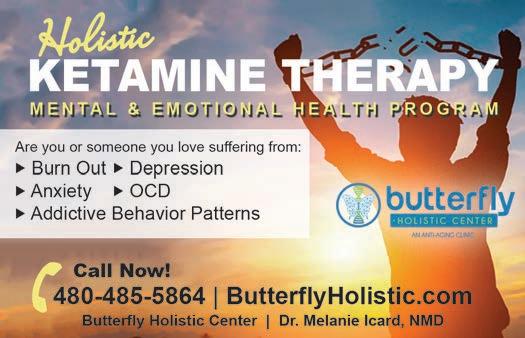
Millions of Americans are spending more time in their homes as employers embrace work-at-home arrangements following the pandemic. Many families have redesigned living spaces to accommodate one or more offices, and as they streamline their abodes, it is important to also take care of any potential hazards.

Some dangers around the house are easy to spot, like toys left in a hallway where people might trip or exposed electrical wires that could cause a fire. Other hazards are not as obvious but equally dangerous. Daily exposure to invisible household toxins, for example, can cause serious health consequences.
Almost beyond comprehension, the average person is exposed to 700,000 to 2 million toxins each day, and some of these are “forever
chemicals” that never leave the body or take decades to be expelled. This huge toxic burden can accumulate in the body, strain the immune system and compromise overall health. “The research is very clear—huge, huge, strong correlations between toxin load and most of your autoimmune diseases,” remarks Joseph Pizzorn, ND, author or co-author of six textbooks for doctors and seven consumer books, including, most recently, The Toxin Solution
The good news is that many of these threats can be corrected with a little insight, planning and budgeting. Changes to our everyday choices can go a long way toward keeping our bodies and homes healthy and safe, while also creating a greener and healthier environment.
The air inside our homes can be up to 100 times more polluted than outdoor air, containing pollutants such as mold, smoke, out-gassing chemicals, pollen, pet dander, bacteria and viruses. There are many portable HEPA and carbon air filter options available at different price points that will help remove contaminants. According to a 1989 Clean Air Study by the National Aeronautics and Space Administration, common houseplants can remove organic pollutants from indoor air and, when combined with activated carbon air filters, are more effective. Examples of such plants are the Boston fern, spider plant, variegated snake plant, peace lily, English ivy, cornstalk dracaena and many other inexpensive varietals.
Flame-retardant chemicals in our sheets, mattresses, mattress pads and even pajamas out-gas minute amounts that can accumulate in our bodies over time. Because we spend approximately onethird of our lives in bed, it is important to ensure that the sleeping environment is as healthy as possible. Consider switching to organic cotton options for all bedroom items. Pressboard furniture is soaked with formaldehyde; replace it with solid wood pieces to reduce exposure to off-gassing. Turn off Wi-Fi at night to reduce exposure to EMF radiation. These changes can be made gradually, as the budget allows; think of them as an investment that will pay off with improved sleep and wellness.
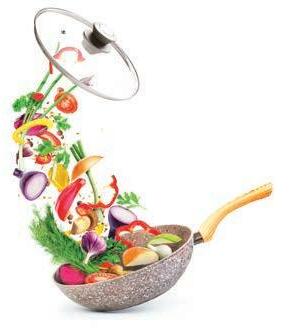
For many of us, turning on the faucet for a glass of water can produce a cocktail of toxic chemicals, including lead, arsenic and per- and polyfluoroalkyl substances (PFAS)—also known as the “forever chemicals.” The Environmental Working Group’s Tap Water Database (ewg.org/ tapwater) provides a searchable database of contaminants found in drinking water by zip code.
Investing in a water filtration system is a great way to avoid these chemicals. They, too, are available at different price points. Whether it’s a countertop unit, a filter
mounted on the faucet, an under-sink device or a whole-house system, the best solutions include charcoal granulation, a two-micron filter and reverse osmosis.
Smart swaps in cookware and bakeware are also a must. Begin by replacing nonstick pans with stainless steel, glass or cast-iron options. If replacing them all at once isn’t economically viable, start with the most damaged and scratched pans and continue as finances allow.
Food storage can be another source of toxins. Studies have found that certain chemicals in plastics can leach into our food. Move away from plastic storage containers to glass, and swap plastic wrap for a non-toxic alternative like beeswax wrap or reusable bowl covers.
Clean the shower head and install a chlorine shower filter. Gradually begin to replace soap and shampoo with nontoxic products that contain all-natural ingredients; specifically look for ones that are paraben-free, gluten-free and organic.
For other personal products such as perfume, move away from synthetic fragrances, which can contain endocrinedisrupting chemicals, and replace them with all-natural alternatives such as essential oils. Toothpaste should be glutenand fluoride-free. Newer options contain hydroxyapatite—a naturally occurring mineral—which can be an alternative to fluoride and help remineralize teeth. Replacing makeup all at once can be costly, so begin with lipstick and lip balms and look for gluten-free alternatives.
While it may feel overwhelming to embark upon a green living journey, positive change doesn’t happen all at once. Pick one area and make baby steps. Even small, incremental actions can have a powerful cumulative impact on the mind, body and planet.

Dr. Tom O’Bryan is the founder of theDr.com, author of The Autoimmune Fix and chief health officer for KnoWEwell, the parent company of Natural Awakenings Publishing Corp.
learn about marketing opportunities at: PhoenixAds@NaturalAZ.com

When a middle-aged, thin adult comes to the hospital with heart attack symptoms, the doctors will ask about family health history; alcohol, drug and cigarette use; current medications; and cholesterol levels. But because the person is thin, they may not question their diet. In reality, the food choices we’ve made since childhood may determine our likelihood of developing heart disease as adults. Heart-healthy diets for kids can establish a healthful baseline and set them on a path to lifelong wellness and longevity.
Studies have demonstrated that the development of coronary atherosclerosis begins in childhood.

These findings have been replicated in studies of children of different ethnic backgrounds across the globe. Characterized by the deposition of fatty material (plaques) on the inner walls of arteries, atherosclerosis contributes to heart disease and heart attacks.
The immediate reaction may be to blame genetics for heart disease in young children and assume it is outside of our control, but this assumption would be wrong. Genetics are only a blueprint. What we eat, how we sleep, our stress level and our exposure to environmental toxins determine how our house is built. “Genetics load the gun, but the environment pulls the trigger,” wrote Judith Stern, professor of nutrition and internal medicine at the University of California, Davis.
According to the Centers for Disease Control and Prevention, epigenetics is the study of how our behaviors and environment can cause changes that affect the way our genes work. Researchers at Duke University Medical Center demonstrated the effects of genetic malleability in a study involving agouti mice that have genetically mutated to produce obese offspring that develop heart disease, diabetes and cancers. The scientists fed two groups of these unhealthy mice different diets. One group ate standard mouse food. The other consumed standard mouse food plus vitamin supplements, including choline, folic acid, B12 and betaine.
The agouti mice mothers that were given a vitamin-supplemented diet produced offspring that were healthy, without evidence of heart disease or other problems, while the mice that ate a regular diet without nutritional supplementation continued to produce terribly unhealthy mice. What humans can surmise from this study is that parents have the power to alter their children’s gene expression and subsequent heart disease risk.
To raise healthy adults, a child’s nutrition is where to start. As Mark Hyman, M.D., an internationally recognized leader in the field of functional medicine, says, “Chronic disease is a foodborne illness,” and one of the biggest dietary culprits
is sugar. It leads to the development of plaque in the arteries and wreaks havoc on the health of Americans. In the 1980s, the low-fat craze prompted food companies to remove fat from foods and replace it with sugar to preserve taste. A whopping 240 sugar alternatives followed, including corn syrup, rice syrup and dextrose.

The liver can process only 24 grams of added sugar per day. Any extra sugar gets turned into fat, which contributes to the development of atherosclerotic plaques. In the U.S., adults consume an average of 77 grams of sugar per day, according to the American Heart Association. That’s more than three times the amount the liver can handle.
Parents can begin to shield their children from this dangerous ingredient by steering them away from sugary drinks. We all know that sodas are full of sugar, but even organic juice boxes, sports drinks, flavored waters and coconut waters contain loads of the stuff. Choose water or coconut water without added sugar, and wean kids off of juice by gradually diluting it. Also consider fruit-infused waters or bubbly, carbonated water with a squeeze of fresh lemon juice.

Start reading food labels and encourage kids to become sugar detectives. It is not about categorizing food as evil or bad. It’s about learning together which foods and drinks help their little hearts become stronger and more resilient. When they grow up to be heart-healthy, middle-aged adults, they will be thankful.
Ana-Maria Temple, M.D., is an integrative pediatrician and wellness educator in Charlotte, North Carolina. Learn more at DrAnaMaria.com.

While most people consider the brain to be the power center of the body, the heart is stronger in several ways. In research pioneered by the HeartMath Institute in the 1990s, the heart has been found to be 40 to 60 times stronger than the brain electrically and about 100 times stronger magnetically.

HeartMath studies heart rate variability (HRV), which measures the naturally occurring beat-to-beat changes in heart rate and rhythms, and is a key marker of overall health, resiliency and longevity. HeartMath discovered people could train themselves to improve their HRV and, as a result, their ability to regulate emotions by using breath as a type of biofeedback.
Central to this work is the vagus nerve, a main component of the parasympathetic nervous system that carries signals at an unconscious level between the brain, heart and digestive system. Due to its many functions, particularly controlling mood, researchers have targeted the vagus nerve in treating depression, anxiety and other psychiatric disorders.
According to a 2018 study, “Vagus Nerve as Modulator of the Brain-Gut Axis in Psychiatric and Inflammatory Disorders,” published in Frontiers in Psychiatry, “Treatments that target the vagus nerve increase the vagal tone and inhibit cytokine production. Both are important mechanisms of resiliency. The stimulation of vagal afferent fibers in the gut influences monoaminergic brain systems in the brain stem that play crucial roles in major psychiatric conditions, such as mood and anxiety disorders. Since the vagal tone is correlated with capacity to regulate stress responses and can be influenced by breathing, its increase through meditation and yoga likely contribute to resilience and the mitigation of mood and anxiety symptoms.”
Vagal tone tells us how well the vagus nerve is functioning, and it is measured indirectly by HRV. A toned vagus nerve can help regulate the nervous system and improve digestion,
heart health and breathing rate. It can also counter the body’s “fight” response and help us relax and bounce back from daily stresses by boosting the “rest-and-digest” response, which also boosts HRV.
Because the vagus nerve is integral to the gut-brain connection, Michael Ruscio, DNM, DC, writes that lifestyle practices that are good for the gut and brain, like diet, exercise and deep breathing, can improve vagal tone. The Cleveland Clinic states that the vagus nerve can be naturally strengthened through meditation, massage, music therapy and cold-water immersion.
Other non-invasive methods of stimulating the vagus nerve include lightly tapping the chest while holding the breath, as well as light-to-moderate massage in areas near the vagus nerve. Because the nerve connects to the throat, gargling with salt water and laughing have also been proposed as potential interventions.
The U.S. Food and Drug Administration has approved electrical vagus nerve stimulation (VNS) for the treatment of
drug-resistant epilepsy and depression, and there are ongoing studies to expand its use for other health conditions and disorders. This is an invasive solution, as the device is surgically implanted under the skin on the chest.
Bruce Cryer, co-founder and former CEO of HeartMath, says, “We could all use a helping hand to get into our happy place” in these uncertain times. The 40-year wellness leader recently turned to Sensate, a new personal device designed to help people improve HRV and derive calming benefits without the need for extensive training in meditation or breathing techniques.
Developed by Stefan Chmelik, a physician, Sensate is a palm-sized device that is simply placed on a person’s chest as it emits stress-relieving sound waves directly to the nervous system using bone conduction. Similar to the comfort a person experiences when a purring cat lies on their chest, Sensate causes the chest to resonate sound, which signals the vagus nerve to relax. When used over time, the device can train (or retrain) the vagus nerve to default to this calming state.
In a 2022 study, adults with and without anxiety and depression disorders used Sensate for an average of three and a half months, five to six days per week. After the test period, more than 70 percent of the participants reported low, mild or normal stress levels. More than 65 percent of the participants with anxiety disorder and over half of those with a depressive disorder reported an improvement in their condition.
Chmelik says, “Stress is a ‘global catastrophe’, and with a chronically stressed public, there is no will or ability to address all the other issues facing us. My goal in developing Sensate was to enable people to self-regulate more efficiently. I want to create a tipping point to create a more conscious world. As more people become aware of their breath and its connection to stress, and take advantage of the powerful tools of meditation, breath and other tools like Sensate, hopefully that tipping point is reached.”
Kirby Baldwin writes and edits for KnoWEwell, the Regenerative Whole Health Hub and the parent company of Natural Awakenings Publishing Corp.
To help celebrate Heart Health Month and Valentine’s Day, take a moment to enjoy this selection of musings from a former pioneer in holistic healing. Breathe deeply; pause between each of them; take in life’s energy and reflect and connect with your intentions and loved ones.
Teaching is for the mind; healing is for the heart.
A daily healing invocation: I open my heart for the Spirit to pass onto those who want Healing through me.
The heart is the way to the Soul. The more open the heart, the more the Soul is revealed.
This may well be the best description of Healing: The healer opens his heart, his love pouring out from him to enfold the sufferer, to bring him into his expanded aura.
And the sufferer, feeling this love, opens his heart to enter the healer’s.
As a holistic healer for almost fifty years who had his practice in his home, Dr. John Diamond (1934-2021) said he wanted to try to make his home a hearth, where the life energy, the heart flame, the flame of love and life of the sufferer may be rekindled to blaze anew. He saw his heart as a flaming beacon for the sufferer lost in distress. Not to come for a fixed time, but to spend time, to visit, living not by the clock, but by the heart. And home can be any place one feels love in their heart. Diamond’s musings, of which he wrote hundreds, are individual pearls of wisdom, each created with the intention of raising the life energy of the reader. Read more at DrJohnDiamond.com. ~ Susan Diamond
Connecting you to the leaders in natural health care and green living in our community. To find out how you can be included in the Business Directory, email PhoenixAds@NaturalAZ.com or visit NaturalAZ.com and download our media kit.
ALLERGY CLEARING TECHNIQUE 480-676-0510
Info@AllergyClearingTechnique.com AllergyClearingTechnique.com
Learn a process to potentially clear food allergy response. Home study course with training manual and training videos. Not NAET. No shots, No drops, No bloodwork—No kidding. See ad, page 27.
Pavel Gershkovich, CHP, CRP, PMP, Therapist 8765 E Bell Rd, Ste 110, Scottsdale 480-621-6041 • ArizonaLeechTherapy.com ArizonaLeechTherapy@gmail.com




Pavel Gershkovich, owner of Arizona Leech Therapy, is a professional medicinal leech therapist. He is here to help you find a natural, drug-free solution for your medical conditions, such as cardiovascular, high blood pressure, migraine, urology/ prostate, varicose veins, and deep venous thrombosis. See ad, page 19.
MacKenzie Kalt, Owner/Director 4050 E Greenway Rd, Ste 5, Phoenix 480-594-5052 • NatPainTreat.com


Providing some of the most advanced natural technologies for those struggling with chronic pain, injuries, stress, migraine headaches, PTSD, insomnia, Lyme disease, autoimmune disorders, skin conditions, and much more. Visit our website to learn more. See ad, inside front cover.
2701 N 7th St, Phoenix 602-307-0888
NaturalMedicineDetox.com
We offer professional medical assistance with one of our Doctors of Acupuncture & Oriental Medicine, MD(H), or Classical Homeopaths. We also have several self-elect options for our many detox services. Please call to schedule a free 15-minute consult to learn what service might be the best option. See ad, page 29.
PIHMA COLLEGE & CLINIC Acupuncture, Herbal Medicine and Homeopathic Clinic 301 E Bethany Home Rd, Ste A-100, Phoenix 602-274-1885 • pihma.edu

PIHMA offers Acupuncture Treatments, Herbal Consultations, Acute and Constitutional Homeopathic Consultations, as well as Auricular Acupuncture, Cupping, Moxibustion, Gua Sha and Tui Na. Our medicines have been used for thousands of years to treat numerous conditions, including pain, stress and more. PIHMA is a teaching clinic and offers affordable pricing.
SW HERB SHOP & GATHERING PLACE
148 N Center St, Mesa 480-694-9931 • SWHerb.com Store.SWHerb.com
Kathy Gould and Madalyn Johnson, herbalists and proprietors, offer medicinal bulk herbs and specialty tea blends, herbal extracts, certification classes, community and therapist rental space, medicine-making supplies, and more. See ad, page 27.

WATERCOLOR ART CLASSES
Allura Westly 3611 E Sunnyside Dr, Phoenix AlluraWatercolor@cox.net 602-469-0524 • AlluraWaterColor.com
Allura Westly, master teacher, opens her sanctuary studio to all levels, beginner to advanced. Learn fluid color technique, drawing and composition. Small class of eight students. No talent required, just a desire to create.
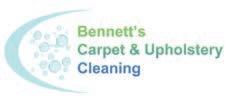
Valleywide Service • 480-994-4988 BennettsCarpetCleaningAZ.com
Eco-friendlycarpet and upholstery cleaning. Featuring organic cleaners and

odor removal products derived from renewable seed and vegetable sources. No perfumes, solvents or other hazardous products. No phosphates. Products also available for in-home use. Licensed and owner operated since 1974. See ad, page 33.
MILLENNIUM DENTAL ASSOCIATES
5705 N Scottsdale Rd, Ste D-110, Scottsdale 480-948-0560
MillDental.com
Millennium Dental offers more than 50 years’ experience in holistic dentistry, including advanced general dentistry Certified by the IABDM. See ad, page 9.
Dr. Michael Margolis and Dr. Stephen Kovar 2045 S Vineyard Rd, Ste 153, Mesa 480-833-2232 • MyDentistAZ.com



A holistic and biological approach to your dental needs and overall health. Bio-compatible dentistry, esthetic dentistry lumineers/veneers, family dentistry and much more. See ad, page 3.
NATURAL DENTAL PARTNERS
3134 W Carefree Hwy, Ste 9, Phoenix 602-775-5120 • MyNaturalDentist.com
The doctors at Natural Dental Partners take the time to listen to your concerns and use their extensive experience to help you achieve better health. Using the latest technology (such as lowdose 3D imaging, CEREC, lasers, PRF, ozone and treatment of sleep disorders), they believe in a team approach to help you achieve your healthcare goals. Check out MyNaturalDentist. com or ABreathOfHealth.com to see how they can help you. See ad, pages 5 and 25.
Melanie Icard, NMD
1430 E Missouri Ave, Ste B127, Phoenix 602-353-7712 • ButterflyHolistic.com

Dr. Icard specializes in biological medicine, peptides, PRP, aesthetics and ozone therapy. Her offerings include holistic antiaging medicine, pain reversal, natural and traditional aesthetics, ozone therapy, holistic ketamine therapy, and sexual health regeneration. See ad, pages 29 and 33.

KIM CARTER, MA, HTCP
15215 S 48th St, Ste 154, Phoenix Kim@IntuitiveKim.com IntuitiveKim.com
Kim is an Intuitive and Healing Touch Certified Practitioner offering guidance when you feel out of alignment with your authentic self. Stress, fear, anxiety and grief/loss throw us off balance, making it challenging to access inner wisdom. Sessions include reading and clearing your energy field; and simple, practical self-healing tools to keep you balanced and grounded. See ad, page 11.
FENG SHUI 81
Lori Thomas Feng Shui Instructor/Practitioner 480-370-3310 • FengShui81.com
Feng shui is a study of how energy flows in one’s home. Lori Thomas offers private consultation and classes to teach how to correct energy imbalances to prevent mishaps in one’s life, improving health, abundance, relationships and more. She is an Intuitive with extensive training in feng shui and healing arts. See ad, page 14.
ARIZONA ORGANIC PEST & TERMITE CONTROL

Organic Pest Control 602-923-1457 • ArizonaOrganic.com
Avoid being exposed to dangerous chemicals when all-natural and safer alternatives work just as well and last longer. See ad, page 11.
ANDREA BRIGGS, AKA “CRITTER DOC”
ASAM, Sh. Reiki, HTAP Animal Communicator and Counselor 602-317-1543 • CritterDoc1@cox.net SpiritAnimalWisdom.com
With a gentle healing touch, Andrea provides earth medicine and energy healing, animal communication, and intuitive counsel for pets and their people.



SOUTHWEST INSTITUTE OF HEALING ARTS
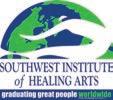
1538 E Southern Ave, Tempe 480-994-9244 Info@swiha.edu • swiha.edu

Nationally accredited college offers holistic health and wellness degrees, diplomas, certificates of excellence, continuing education and personal development, oncampus and online. Financial aid available. See ad, outside back cover.

11108 N Frank Lloyd Wright Blvd, Ste E16, Scottsdale 732-832-1036
DimensionsOfHeavenAndEarth.com
Dimensions of Heaven and Earth is Scottsdale’s exciting, new one-stop Spiritual Experience: a center of healing and insight combined with a store full of unique gifts from local artisans. With training and tools for your personal development, we are excited to help you take your spiritual journey to new levels! See ad, page 26.

The Path of Spiritual Freedom 1-877-300-4949 • EckankarArizona.org Eckankar.org • HearHU.org Facebook.com/EckankarArizona
Eckankar is an active, individual, creative spiritual practice. A companion and roadmap for your journey home—to the heights of SelfDiscovery and God-Discovery, and beyond. Come along and discover the most secret part of yourself. The key to spiritual freedom lies within you. Explore life as a Soul Adventure. See ad, page 19.
THE SUMMIT LIGHTHOUSE OF PHOENIX
4105 N 20th St, Ste 115, Phoenix 480-442-5020
SummitLighthousePhoenix@gmail.com

SummitLighthousePhoenix.org
Dedicated to sharing Saint Germain’s Violet Flame. All faiths welcome. Learn how you can become a modern day mystic. We are dedicated to sharing the Teachings of the Ascended Masters® to help you bring in joy and peace to the world. Learn what the requirements are to make your ascension. See ad, page 14.
Please note that all deadlines (advertising and editorial) are the 10th of the month prior to the edition being published. For example, February 10 is the deadline for all March edition submissions.

Find additional articles online at NaturalAZ.com. Go to the homepage and explore local businesses and articles exclusively from Natural Awakenings.

123rf.com/lola1960
NOTE: Please check market websites and ArizonaCommunityFarmersMarkets.com for more information on days and hours, and any restrictions.

Ahwatukee Farmers Market
4700 E Warner Rd, Phoenix
Sundays Oct-May 9am-1pm Jun-Sep 8am-11am Facebook.com/AhwatukeeFarmersMarket
Care 1st Farmers Market
328 W Western Ave, Avondale
Tuesdays Jul-Oct 8am-noon
ArizonaCommunityFarmersMarkets.com
Carefree Farmers Market
1 Sundial Circle
Fridays Oct-May 9am-1pm Jun-Sep 8am-11am
Facebook.com/CarefreeFarmersMarket
Downtown Chandler Farmers Market
3 S Arizona Ave
Saturdays Oct-May 9am-1pm Jun-Sep 7am-10:30am Facebook.com/ChandlerFarmersMarket
Downtown Mesa Farmers Market
1 E Main St
Saturdays 8am-noon dtMesaFarmersMarket.com
Downtown Phoenix Farmers Market
721 N Central Ave
Saturdays Oct-Apr 8am-1pm May-Sep 7am-11am
DowntownPhoenixFarmersMarket.org
Gilbert Farmers Market 222 N Ash St Saturdays Oct-Mar/Apr 8am-noon Apr/May-Sep 7am-11am GilbertMarket.com



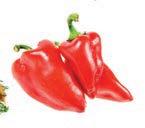
High Street Farmers Market 5415 E High St, Phoenix Sundays Oct-May 10am-1pm Facebook.com/Farmers-Market-on-HighStreet-2244771575799425
Mommas Organic Market
Arrowhead Farmers Market 7780 W Arrowhead Towne Center, Glendale Saturdays Oct-May 9am-1pm | Jun-Sep 8-11am Facebook.com/Getlocalazfarmersmarkets GetLocalArizonaEvents.com
Mommas Organic Market
Glendale Farmers Market at Cabela’s 9380 W Glendale Ave, Glendale, AZ 85305 Sundays Sep-May 10am-2pm | closed for summer Facebook.com/Getlocalazfarmersmarkets GetLocalArizonaEvents.com
Old Town Scottsdale Farmers Market
3806 N Brown Ave Saturdays 8am-1pm
ArizonaCommunityFarmersMarkets.com
Power Road Farmers Market 4011 S Power Rd, Mesa Monday-Saturday 9am-5pm | Sunday 9am-4pm PowerrdFarmersMarket.com
Roadrunner Park Farmers Market
3502 E Cactus Rd, Phoenix
Saturdays Oct-May 8am-1pm | Jun-Sep 7am-11am
Facebook.com/RoadrunnerParkFarmersMarket
Singh Meadows Farmers Market
1490 E Weber Dr
Fridays, Saturdays & Sundays 8am-2pm Facebook.com/SinghFarms
Sun City Farmers Market
16820 N 99th Ave
Thursdays Oct-May 9am-1pm Facebook.com/Sun-City-Farmers-Market631299790224049
The Capitol Farmers Market
1700 Adams St, Phoenix
Thursdays 10:30am-1:30pm
ArizonaCommunityFarmersMarkets.com
Uptown Farmers Market
5757 N Central Ave, Phoenix
Wednesdays Oct-Apr 9am-1pm & May-Jun 8am-noon
Saturdays Nov-Apr 9am-1pm & May-Oct 8am-noon UptownMarketAZ.com
Verrado Community Farmers Market

N Market Pl & W Main St, Buckeye Sundays Oct-Jun 9am-1pm Facebook.com/VerradoCommunityFarmersMarket
Flagstaff Community Farmers Market
211 W Aspen Ave, City Hall Parking Lot Sundays May-Oct 8am-noon FlagstaffMarket.com
Prescott Farmers Market
Dignity Health, YRMC
900 Iron Springs Rd, Miller Valley Lot Saturdays 7:30am-noon PrescottFarmersMarket.org
Sedona Summer Community Farmers Market
Tlaquepaque/Creekside, 336 Hwy 179 Fridays May-Oct 8-11:30am
Sedona-Farmers-Market.com
Sedona Winter Community Farmers Market
Wells Fargo Bank Parking Lot 2201 W State Rte 89A, West Sedona Sundays Oct-May noon-4pm
Sedona-Farmers-Market.com



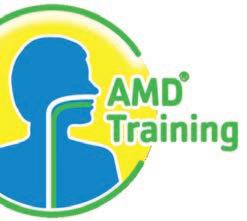
“Holistic Mouth” intervention framework for correcting the root causes of many conditions that are otherwise very difficult to permanently resolve.
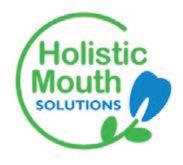
“I can’t unsee it [signs of impaired mouth] now. Every time I take a class with Dr. Liao, I leave with at least a dozen new pearls of knowledge. It’s has been life-changing and paradigm-shifting.” – Dr. Teresa Scott, Spring, Texas


